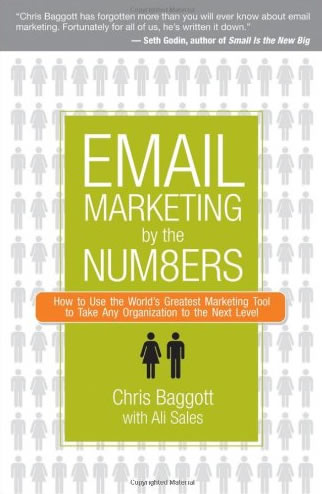Chris Baggott's keys to optimising email marketing
 Today we talk about what we consider one of the best books to learn the keys to get the most out of our email marketing strategies. It is "Emal Marketing By The Numbers"by Chris Baggott. The book starts with some basic marketing ideas and then goes on to provide more concrete keys on how to improve the effectiveness of our email campaigns and also offers a multitude of "Case Studies" that illustrate each point.
Today we talk about what we consider one of the best books to learn the keys to get the most out of our email marketing strategies. It is "Emal Marketing By The Numbers"by Chris Baggott. The book starts with some basic marketing ideas and then goes on to provide more concrete keys on how to improve the effectiveness of our email campaigns and also offers a multitude of "Case Studies" that illustrate each point.
The following are some of the key points that can serve as a "checklist". when generating our email campaigns:
- Focus on customer RELATIONSHIPS and not on CAMPAIGNS.
We often tend to focus on the objectives and results of the campaign we have in front of us. Measuring numbers and obtaining statistics, but without a deep analysis of the relationship that we are generating with the audiences of our email strategy. This relationship should be the starting point and the object of evaluation. Our objective should not be to obtain figures, but to lengthen and optimise the Life Cycle of our prospects (LTV).
- Quantity is nothing, quality is everything.
Baggott repeats throughout the book the idea that size is not everything. A list with thousands of prospects can be totally useless if these recipients are not engaged with the company sending the message or interested in what it has to say.
- Refine the database and segment to deliver truly relevant content.
In the same vein as the previous point, the book relies on exhaustive segmentation, double opt-in record collection to ensure user engagement and constant testing to ensure interest in our subscription list.
- Past Behaviour, Relevance, Frequency and Creativity.
These are, in order of importance, the factors that influence user behaviour. What they have done (and what they have spent) in previous campaigns, the relevance of the content (which is optimised through testing and segmentation), the frequency with which you send emails (there is no universally valid frequency, it depends on many factors) and, lastly - so it should not consume much of our effort - the creativity of the email.
- Everything can be tested.
The secret to success is to continually test what we do (when we can) to correct our trajectory and focus on what really works.
In the final chapters of the book, we find some more concrete and tactical advice, such as enabling email sharing to encourage the virality o integrating our website with our email marketing strategy so as to automate some deliveries with respect to actions carried out on the website, thus saving time and resources.
Finally, Baggott gives us one last important piece of advice: Don't be a spammer. In theory, we will avoid becoming spammers as long as contact with the recipient is explicitly allowed, however there are some technical factors that can be interpreted by email services in a negative way, causing them to mark us as spam. However, the topic of how to avoid becoming a spammer is sufficiently extensive that we will devote an article to it exclusively on another occasion.
What other books would you recommend to include in our email marketing library?